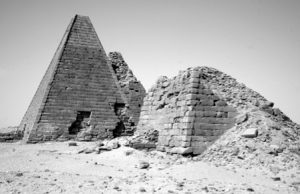An advantage of writing for Rye News is that one encounters a variety of activity one would be unlikely to stumble across otherwise.
I count myself among the privileged few to have explored, some 35 years ago, the Nabatean Necropolis of Medain Saleh in the Hijaz region of Arabia so it was with some kindred spirit that I recognised the delight conveyed by Stephen Gray’s presentation of his “hobby interest” in the Pyramids of Kush in South Sudan.
Stephen, a retired architect, active architectural archaeologist and regular contributor to the Winchelsea Archaeology Society, gave, in the New Hall on Saturday October 13, a fascinating account of his travels in the Sudan focusing on the difference between the Egyptian pyramids and those found in the area around Jebel Barkal.

Beginning with an outline of the parallel development and decline of ancient Egypt and the Kingdom of Kush from 3000 BC, Stephen concentrated on the late Bronze Age and early Iron Age periods and in particular the Kushite Pyramids at Nuri.
The relationship between the civilisations varied over the centuries from trade in ivory, spices and gold, through Egyptian annexation and domination of Kush, Assyrian depredations, the eventual Kushite rule of Egypt by the 25th Dynasty Black Pharaohs and final Ptolomaic, Meroitic and Roman induced decline.

Given his architectural bent Stephen not surprisingly addressed the contrasting design and construction of the respective pyramids.
The Egyptian pyramids are those familiar to most us; the great pyramid of Giza in the Valley of the Kings for comparative purposes is shown here.
The pyramids in Kush are much smaller and have a different configuration. There were cultural differences also.
The Kushite funerary ritual involved burying the body of the dead king in the ground. His successor then built the pyramid on top with a steep access via a walled precinct and pyloned offertory temple or chapel. The pyramid comprised two courses of masonry stone with a ribbed hip, a rubble core and a flat top.


The Meroé necropolis has significant differences. The building practice evolved over time, becoming smaller and steeper as shown above.
The Jebel Barkel necropolis is now a UNESCO World Heritage site and there is considerable archaeological activity going on there in conjunction with the development of tourism.
The Egyptian pyramids were, in contrast, built by the pharaohs prior to their death and contained chambers in the heart of the structure. There is still speculation regarding the construction of the Egyptian pyramids but vast inclines or ramps of sand and thousands of slaves plus the use of levers seems to have currency.

The method of construction suggested by Stephen Gray for the Kushite variety is the shaduf. The shaduf is traditionally an irrigation device but is basically a counterpoised lever so it may well have been employed in construction.
The other fascinating insight was the use of a “seked” to determine the face and hip angles of the pyramids. The seked is basically a measuring device shown in the photograph and comprises a cubit or arm length divided into 7 palms and 28 digits. Equipped with a plumb bob it allowed the accurate measurement of length and angle.
As I indicated at the outset Stephen’s reaction to his Pyramids of Kush struck a chord which resonated with my own experience at Medain Saleh. I completely understand Stephen’s answer as to why he does it. He quoted Howard Carter who, when asked by Lord Caernarvon “What do you see?”, responded “Wonderful things.”
Image Credits: Gerard Reilly , Stephen Gray .



